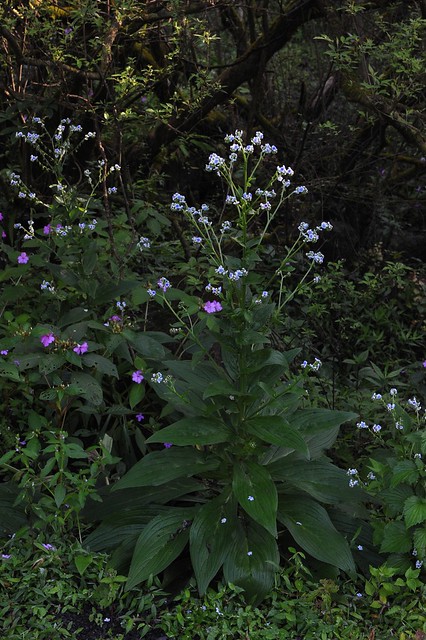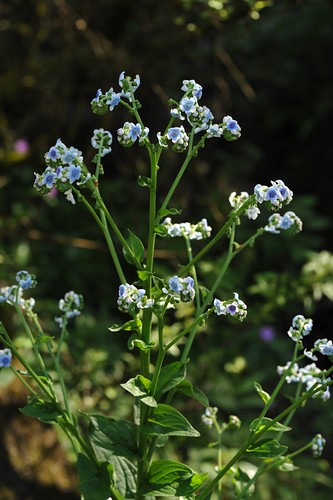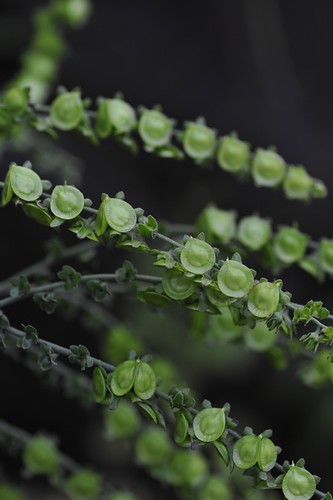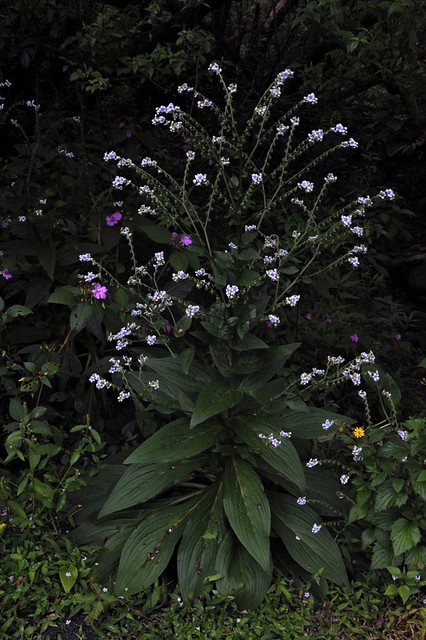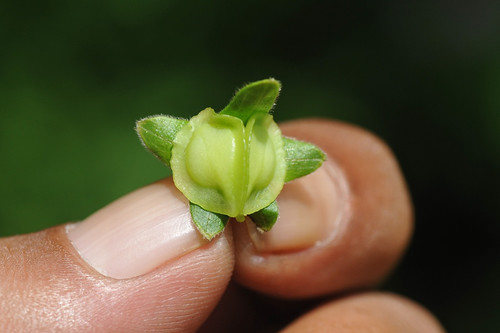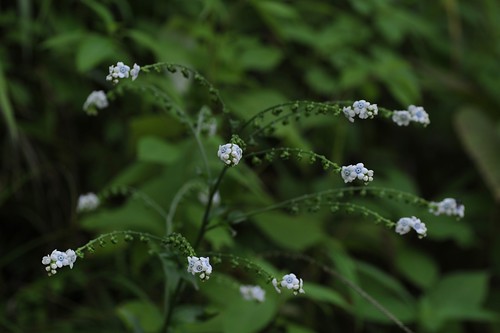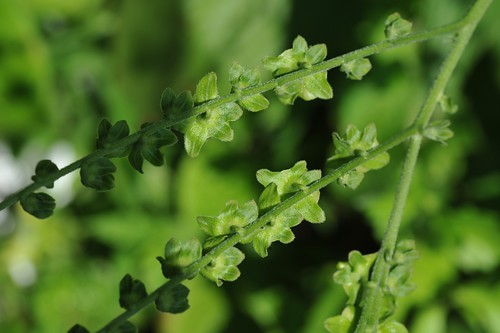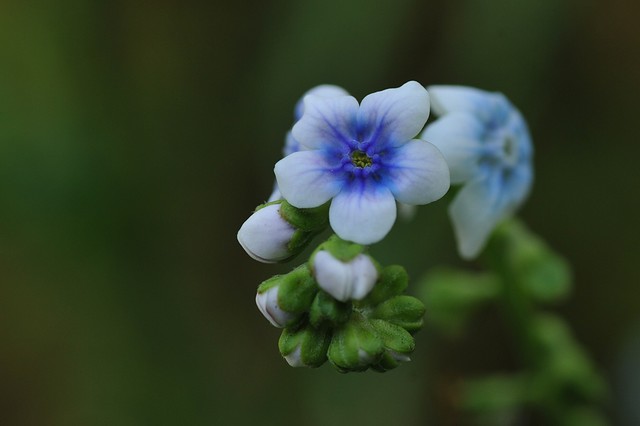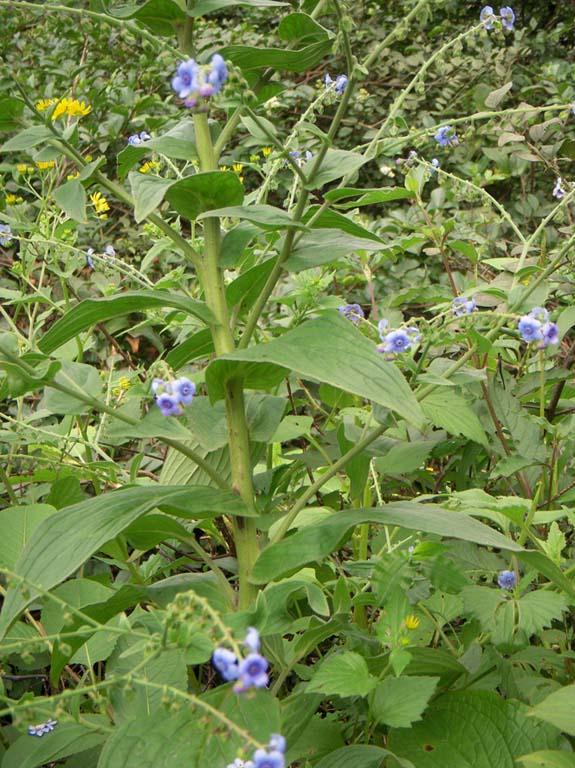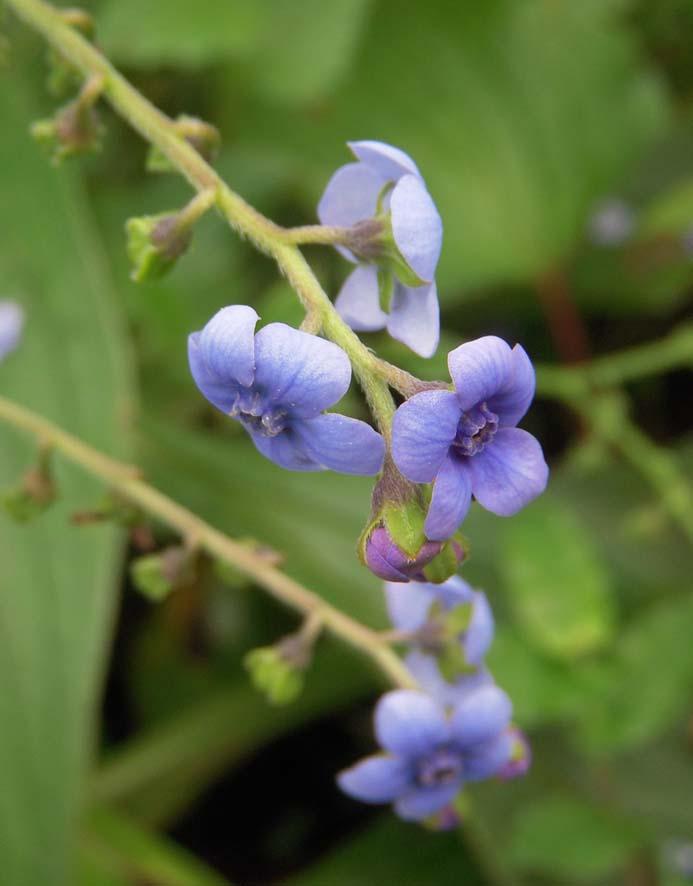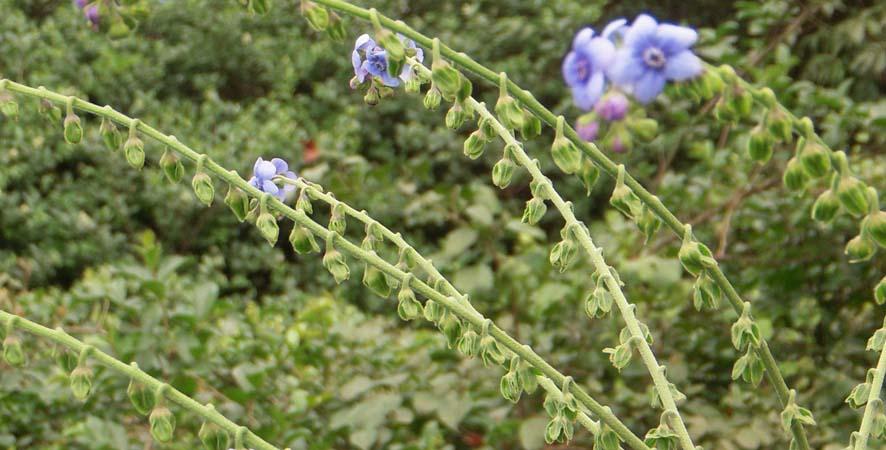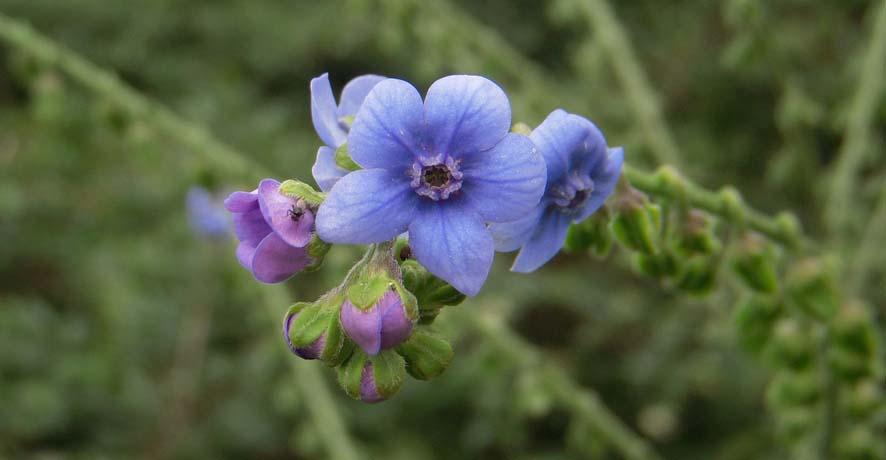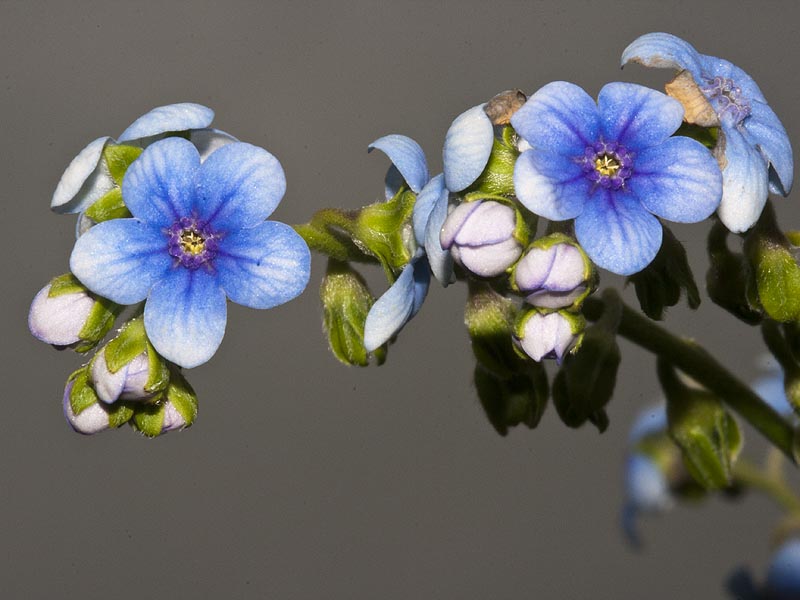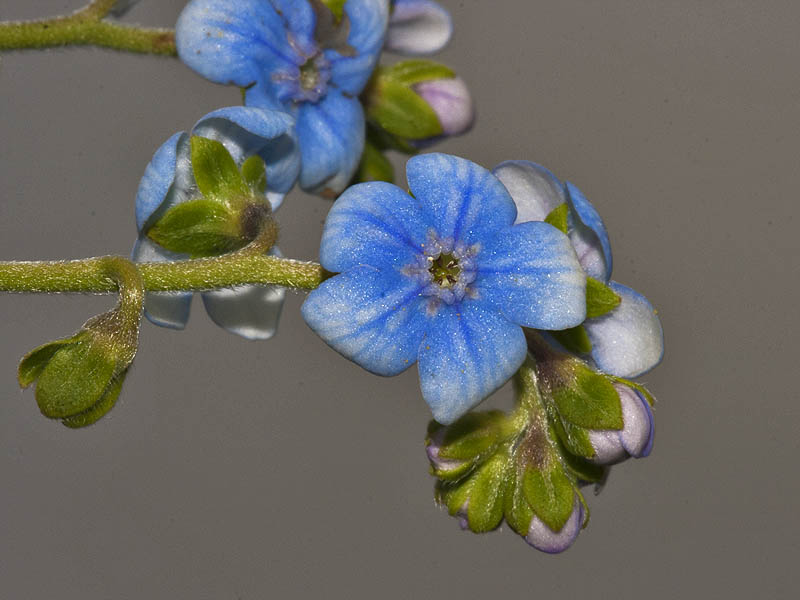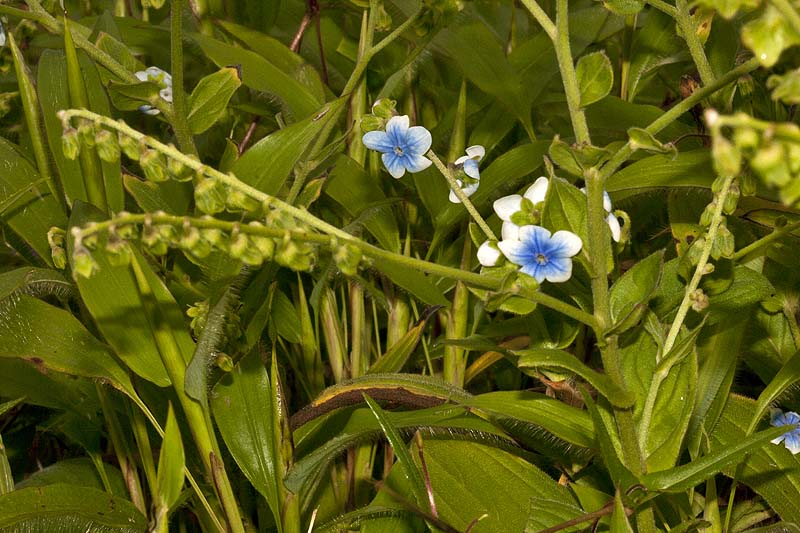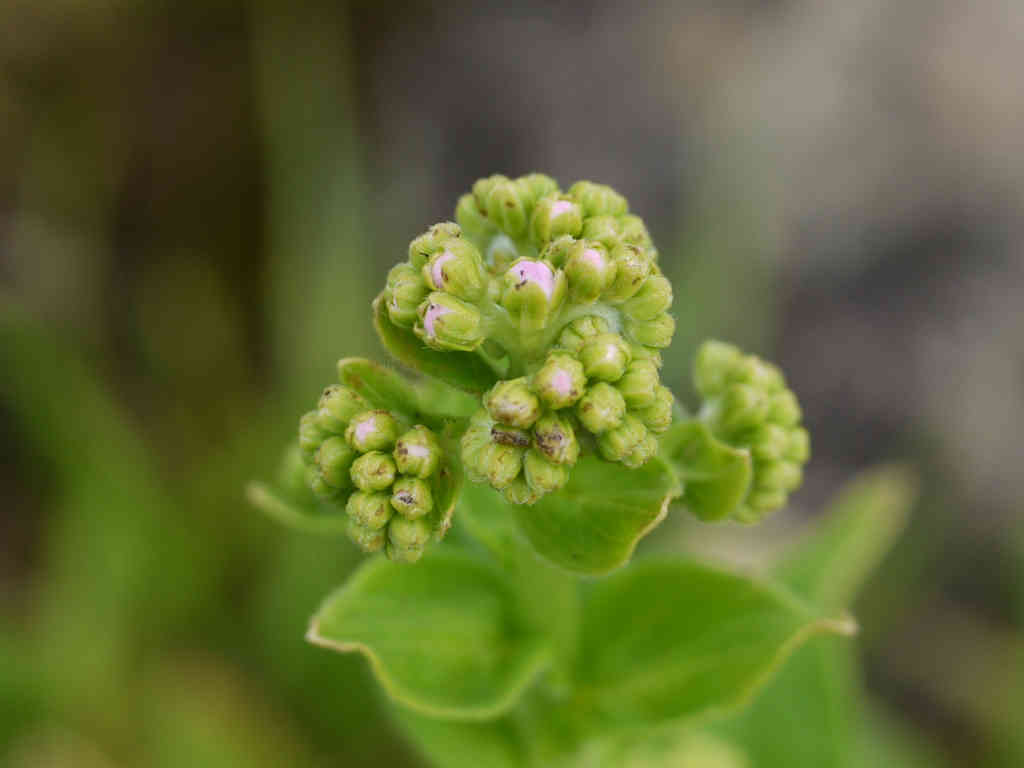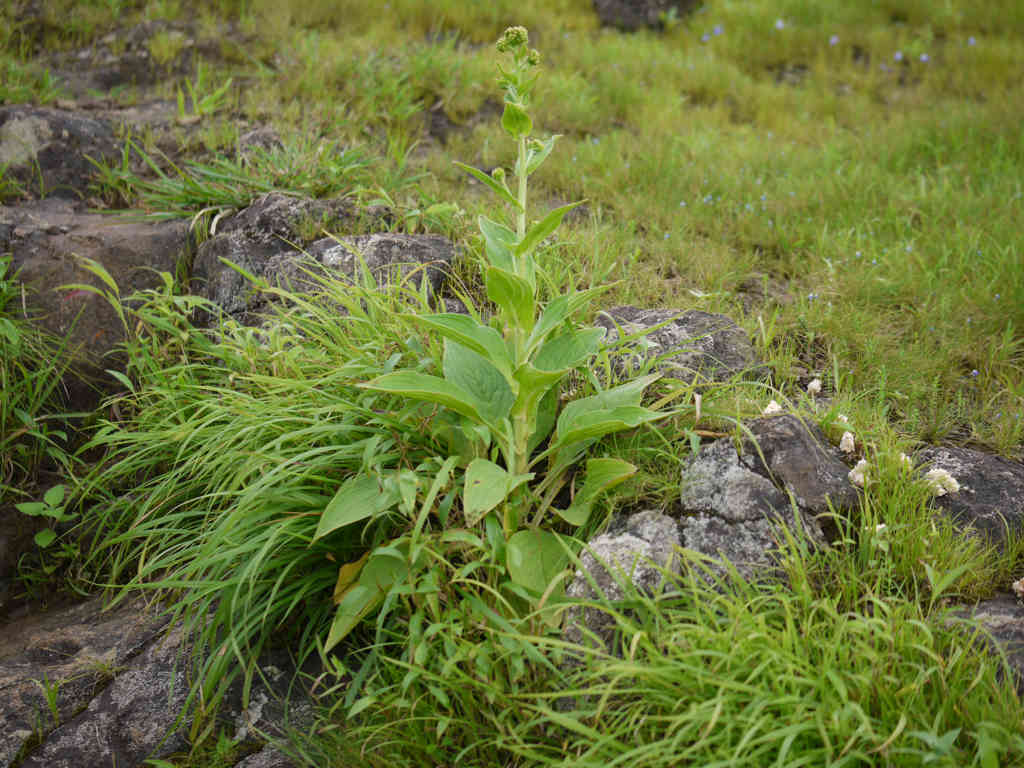Adelocaryum lambertianum (C.B.Clarke) R.R.Mill, Edinburgh J. Bot. 67(1): 152. 2010 [16 Feb 2010] (Syn: Boraginaceae Paracaryum lambertianum C.B.Clarke Fl. Brit. India [J. D. Hooker] iv. 161. ); . a-del-oh–KAR-ee-um — Greek: adelo (unknown, secret, or hidden) and karyo (nut) lam-ber-tee-AY-num — probably named for Aylmer Bourke Lambert, British botanist . commonly known as: Lambert’s borage • Marathi: हिरवी निसुर्डी hirvi nisurdi .. Names bibliography at https://dineshvalke.blogspot.com/ . Endemic to: n Western Ghats (of Maharashtra, India) . The key to Paracaryopsis (Paracaryum in old literature including Cooke) species is : 1. Nutlets glochidiate 2. Stem red, flowers pale blue with a darker centre —- P. coelestinum (Paracaryopsis coelestina (Lindl.) R.R.Mill is a synonym of Adelocaryum coelestinum (Lindl.) Brand) 2. Stem green, flowers dark blue uniform in colour without a dark centre …… P. malabaricum (Paracaryopsis malabarica (C.B.Clarke) R.R.Mill is a synonym of Adelocaryum malabaricum (C.B.Clarke) Brand) 1. Nutlets NOT glochidiate ———- P. lambertianum (Paracaryopsis lambertiana (C.B.Clarke) R.R.Mill is a synonym of Adelocaryum lambertianum (C.B.Clarke) R.R.Mill) . Flora of 2008 : Attachments (1). 3 posts by 3 authors. This is one the most beautiful flower which I had photographed Really wonderful!!! Hat off to you, … Here was some confusion with Paracaryopsis coelestina, but I think it’s gone with discussions at flowersofindia However, still it will be better to see other parts including leaves of the plant. Do you have any other pictures, …? Where and when was it photographed DV :: 25 SEP 11 – 0905 :: Adelocaryum ¿ lambertianum ?: Please validate this plant to be Adelocaryum lambertianum; photographed by my flickr friend Ryan Brookes at Ambenali Ghat (~2500 asl) near Pratapgad, Maharashtra on two different dates 25 SEP 2011 and 3 OCT 2011. My friend’s guess (as well as mine) is strongly based on …. comment at https://groups.google.com/forum/… Calling … also to validate this ID. 25 SEP 2011 25 SEP 2011 [image: Adelocaryum ¿ lambertianum ?]<http://www.google.com/…> [image: Adelocaryum ¿ lambertianum ?]<http://www.google.com/…> Please see the difference in growth of the plant in matter of 8 days 25 SEP 2011 3 OCT 2011 3 OCT 2011 [image: Adelocaryum ¿ lambertianum ?]<http://www.google.com/…> [image: Adelocaryum ¿ lambertianum ?]<http://www.google.com/…> [image: Adelocaryum ¿ lambertianum ?]<http://www.google.com/…> [image: Adelocaryum ¿ lambertianum ?]<http://www.google.com/…> 3 OCT 2011 3 OCT 2011 3 OCT 2011 [image: Adelocaryum ¿ lambertianum ?]<http://www.google.com/…> [image: Adelocaryum ¿ lambertianum ?]<http://www.google.com/i…> [image: Adelocaryum ¿ lambertianum ?]<http://www.google.com/…> Oh Yes. This is THE Adelocaryum lambertianum= Mattiastrum lambertianum= Parakaryopsis lambertianum (this last name I feel fits the best- considering its affinities). Very beautifully illustrative photos of the fruits. This character leaves no doubt in id as the flowers exhibit no specific difference from the rest of the species. . Boraginaceae Week :: Adelocaryum lambertianum along Ambenali Ghat: Adelocaryum lambertianum (C.B.Clarke) R.R.Mill a-del-oh–KAR-ee-um — from the Greek adelo (unknown, secret, or hidden) and karyo (nut) lam-ber-tee-AY-num — probably named for Aylmer Bourke Lambert, British botanist … Dave’s Botanary Oct 3, 2011 … Ambenali Ghat, Maharashtra … photo taken by my flickr friend, Ryan Brookes last week at mahabeleshwar the stems were green, and the shape of the leaves more pointed in contrast adelocaryum coelestinum unfortunately i did not notice the nutlets would very much appreciate a confirmation Me too get a feeling that it could be Adelocaryum lambertianum (please note the spelling …) … but cannot stress strongly. Hope you get a chance to visit the plant in a week or two to check the nutlets. I wish I could but mahabeleshwar is a bit far Boraginaceae Week: Adelocaryum sp. for ID: These herbs were shot on the edge of a cliff in Mahabaleshwar.. Cant help you with the ID but must tell you love your pics In fact that’s the right way to photograph on Macro mode. If all the pictures are taken in field then pl see the flower close up. Background is completely blank. In small objects to bring out the details this is the best method. On 400 ISO with 200 shutter speed photograph taken with the use of flash on F 32. F 32 providing very good depth of field so most of the picture is in sharp focus. most of the pictures published in Macro Photography teaching books are taken with the help of Tripod to get the maximum depth of field. Yes … Tripod is recommended for macro photography, but during last three months that I have used it, I find it difficult to spare so much tome when you are in field and have to grab more than 100 plants or so in different angles. I manage (canon 550d and 100 mm macro) with holding my hands as stable as possible to click close ups. I take multiple photographs, so that one or two in focus can be short listed. you seem to have access to good books, … but… I think matches with images at Adelocaryum lambertianum (C.B.Clarke) R.R.Mill …: You are right as far as theoretical knowledge is concerned, but practically … what you describe is not practical… In the field its not possible to lug a tripod along with a ball head, quick release plate, and four-way focusing rail along with one’s 100 to 200 mm macro, various ND and enhancing filters and a flash or two on a DSLR with the batteries…. these small flowers would need to be in perfect focus and so a focusing rail would be a must …
Please ID this plant captured at Rajgad near Pune in Dec 2014. It seems to be Paracarium sp. of Family Boraginaceae. For confirmation needs the flower. Adelocaryum lambertianum (C.B.Clarke) R.R.Mill as per images herein. . Names of Plants in India :: Adelocaryum lambertianum: Adelocaryum lambertianum (C.B.Clarke) R.R.Mill, comb. nov. [image: Flowers of India]<flowersofindia> [image: Discussions at efloraofindia]<https://groups.google.com/forum/…> [image: more views in flickr]<http://www.flickr.com/search/> [image: more views on Google Earth]<http://api.flickr.com/services/…> *a-del-oh–KAR-ee-um* — from the Greek *adelo* (unknown, secret, or hidden) and *karyo* (nut) *lam-ber-tee-AY-num* — probably named for Aylmer Bourke Lambert, British botanist *commonly known as*: Lambert’s borage<https://sites.google.com/site/indiannamesofplants/…>• *Marathi*: हिरवी निसुर्डी hirvi nisurdi<https://sites.google.com/site/indiannamesofplants/…> *botanical names*: *Adelocaryum lambertianum* (C.B.Clarke) R.R.Mill, comb. nov. … *synonyms*: *Mattiastrum lambertianum* Brand • *Paracaryopsis lambertiana* (C.B.Clarke) R.R.Mill • *Paracaryum lambertianum* C.B.Clarke ~ ~ ~ ~ ~ ~ ~ ~ ~ ~ ~ ~ ~ ~ ~ ~ ~ ~ ~ ~ ~ ~ ~ ~ ~ ~ ~ ~ ~ ~ ~ ~ ~ ~ ~ ~ ~ ~ lam-ber-tee-AY-num — probably named for Aylmer Bourke Lambert, British botanistcommonly known as: Lambert’s borage • Marathi: हिरवी निसुर्डी hirvi nisurdi botanical names: Adelocaryum lambertianum (C.B.Clarke) R.R.Mill … synonyms: Mattiastrum lambertianum Brand • Paracaryopsis lambertiana (C.B.Clarke) R.R.Mill • Paracaryum lambertianum C.B.Clarke … The Plants List (2013). Version 1.1. Bibliography / etymology ~~~~~ ENGLISH ~~~~~ Lambert’s borage
~~~~~ MARATHI ~~~~~ हिरवी निसुर्डी hirvi nisurdi
~~~~~ x ~~~~~ Names compiled / updated at https://dineshvalke.blogspot.com/
. References: IPNI Flowers of India (Adelocaryum lambertianum syn. Paracaryum lambertianum, Mattiastrum lambertianum & Paracaryopsis lambertiana) India Biodiversity Portal (Adelocaryum lambertianum syn. Paracaryum lambertianum, Mattiastrum lambertianum & Paracaryopsis lambertiana) The Plant List (Paracaryopsis lambertiana (C.B.Clarke) R.R.Mill- Unresolved) |
Adelocaryum lambertianum
Updated on December 24, 2024

